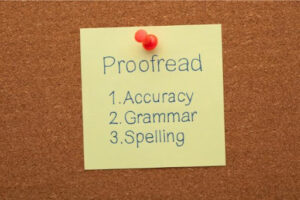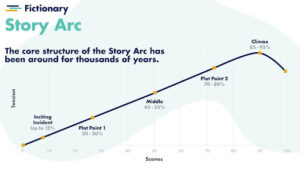
I recall the moment I capped off the last sentence of my first book, a wave of accomplishment washed over me. In that second, I was on top of the world! “I’ve written a book!” However, once the celebratory confetti settled, I faced two huge questions: “What now?” and “How can I find out how to edit a novel?” The idea of editing can be quite daunting, especially for a greenhorn writer, like I was back then.
Flashback to those days, and you’d find me navigating a labyrinth of post-it notes and a monstrous spreadsheet.
I’d manually record each scene, subplot, and character twist.
Let’s not even talk about keeping track of what happened when. It was nothing short of chaos. My editing process was like putting together a puzzle blindfolded.
Thank the writing gods for Fictionary.
Today, I’ve got Fictionary as my trusty sidekick.
This remarkable tool has metamorphosed the editing ordeal into a manageable, easy to follow revision plan. It still takes time and sweat (a lot!), but at least now, the journey from draft to polished manuscript is more like a scenic drive than a voyage into the unknown.
So, why don’t we peel back the curtain for my editing process?
As writers, we’re not just creators of worlds, we’re also sculptors, chiselling and smoothing until we reveal our masterpiece.
It’s time to put away the champagne and gear up for the next climb…
The peak known as editing.
Before you cringe, I promise you, it’s not as dreadful as it seems. With the right strategy and frame of mind (and a handy tool like Fictionary), the question of how to edit a novel can become a rewarding part of your writing adventure.
In this article, we’ll journey together through the wild terrain of novel editing, marking the trail with my top 8 tips, including:
- Celebrating your completed first draft
- Letting your manuscript rest
- Story editing
- Prose editing
- And more…
I’ll also answer some FAQs on book editing.
Ready?
Let’s dive into the wild, wonderful world of novel editing.
How to Edit a Book: 8 Fantastic Tips
1. Celebrate!

Ready, set, celebrate!
Yes, you heard that right.
The first step in the novel editing process might be a bit of a surprise. It’s taking the time to celebrate your accomplishments.
You’ve just put the finishing touches on your first draft. That’s an enormous deal! Celebrating is something many writers forget to do or even struggle with. Maybe because they’re so focused on the mammoth task that lies ahead: editing. Or perhaps they’re so entangled in the world of their characters that they forget they’re allowed to come up for air and—you know—party.
But here’s the thing, fellow scribes…
Celebrating your achievements is a critical part of maintaining a positive attitude towards your work. When you take a moment to step back and appreciate your effort, it’s like sending a high-five to your brain. It boosts your confidence, recharges your creative energy, and prepares you mentally for the next stage.
So before you dive into editing, give yourself a pat on the back, do a little dance, eat that piece of cake, or whatever floats your celebration boat.
You’ve earned it!
And remember, no celebration is too small or too big. It’s all about acknowledging your hard work and giving yourself the credit you deserve. You did it! Now, let’s get that manuscript polished to perfection.
2. Before Beginning Book Edits, Let It Rest

Alright, are you still buzzing from your well-deserved celebration? Good. Now, let’s move on to the second step in your editing journey, which is—wait for it—doing nothing. It’s time to set your manuscript aside and let it rest.
I know, I know, you’re itching to dive into those edits, but trust me on this one.
Why wait, you ask?
Because right now, you’re too close to your work.
You’ve spent so much time and energy crafting this story that it’s practically imprinted in your neurons. If you try to edit immediately after finishing your first draft, you’re likely to gloss over mistakes. That’s because your brain automatically fills in the gaps.
Letting your manuscript rest gives you the chance to detach from your story and return to it with a fresh, objective mindset.
It helps to reset your brain, so to speak.
Think of it as a palate cleanser between courses of a gourmet meal.
So, how long should you wait?
It varies from writer to writer, but a few weeks can be a good cooling-off period. Use this time to recharge your creativity. Read a book, binge a new series, or engage in another hobby.
Your manuscript will be there when you get back, ready for a sharp-eyed review.
3. Make Your Story Revision Plan
Revving up for round two with your manuscript?
Excellent!
Now, let’s strategise—don’t go in unarmed. It’s time to create a Story Revision Plan, and let me tell you, this is where Fictionary comes into its own.
Think of Fictionary as your personal story surgeon. It breaks your narrative down into vital elements, including:
- Story Arc
- Character Goals
- Conflict & Tension
- Entry & Exit Hooks
- Immersive Settings
- And more…
So, using Fictionary, you can evaluate and then recalibrate each element in your manuscript.
Imagine it as a system of checks and balances for your story. Is your narrative arc more of a flatline than a rollercoaster ride? Fictionary will flag it up. Do your characters’ goals have less direction than a headless chicken in a maze? Fictionary’s got you covered. And don’t even get me started on if your tension is as taut as a saggy rubber band.
Once you’ve identified these issues, you can make a plan of action to rectify them.
This is your Story Revision Plan. It’s like a roadmap to a stronger manuscript, and trust me, you’ll wonder how you ever edited without it.
4. Revise Your Story
Let’s roll up our sleeves and get into the details of what revising your story really means.
After your well-deserved break, and armed with your trusty Story Revision Plan, you’re ready to get down to business. So, here’s a handy list of tips to guide you on your editing journey:
Reintroduce Yourself to Your Story
After your break, reacquaint yourself with your characters, plot, and themes. It’s like meeting an old friend, one who might have borrowed and stretched out your favourite sweater, but you’re glad to see them.
Apply Your Story Revision Plan
Focussing on key story elements (like Story Arc and Character Goals) has given you a unique perspective on your story. Use these insights to sharpen your characters’ goals or revamp your narrative structure. Your work deserves the best, so let’s turn your manuscript into a riveting story readers love.
Focus on Key Story Elements
The key story elements are:
- Story Arc
- Character Goals
- Conflict & Tension
- Entry & Exit Hooks
- Immersive Settings
These are the backbone of any unforgettable story. Don’t let them languish. Breathe new life into these areas.
Embrace Change
As you revise, remember, change is good, especially when it leads to a richer, more riveting story. It may be hard to let go of certain parts of the narrative, but trust in the process and in your ability to create something even better.
Editing might feel daunting, but always remember, you’re a literary superhero.
With your cape (or cosy editing sweater), your Story Revision Plan, and your passion for storytelling, you’re all set to make your manuscript the best it can be.
5. Make Your Prose Revision Plan

Once you’ve massaged your story into an interesting narrative, it’s time to switch gears.
Think of this as moving from macro to micro. We’ve worked on the story, but now it’s time to zero in on the nitty-gritty details. The words themselves. We often refer to this phase as copyediting, and it involves crafting your prose to make it shine.
At this stage, your goal is to enhance readability and clarity. You want to ensure your sentences flow, your words hit home, and annoying typos and grammar issues don’t distract your reader.
It’s all about the details here, folks, and these are the aspects you’ll be looking at:
Spelling and Grammar
Use a good spell checker and grammar tool. No matter how careful you are, these little devils sneak in. A thorough check is an absolute must.
Punctuation
Too many commas, or not enough? Should that be a semicolon instead? Punctuation can change the pace and meaning of a sentence, so ensure yours is on point.
Word Choice
Be vigilant about redundancy and overused phrases. Aim for clarity, precision, and variety in your language.
Sentence and Paragraph Length
Vary these to maintain reader interest. Remember, walls of text can intimidate!
Consistency
This is crucial. Make sure you’re consistent in your spelling, character descriptions, and formatting.
Creating your Prose Revision Plan with these elements in mind will help ensure your manuscript isn’t just good, but exceptional. Ready to refine your prose to perfection? Onwards, fellow wordsmiths.
6. Revise Your Prose
Having your Prose Revision Plan in place is a crucial first step, but now it’s time to wield that editorial scalpel and start refining your manuscript.
This is the stage where you’ll be diving deep into the language, structure, and style of your manuscript. You’re going to be examining every word choice, every punctuation mark, and every sentence structure. It may seem intimidating, but this detailed combing is essential for turning a good book into an unforgettable one.
Here’s how to revise your prose:
Start with the Spelling and Grammar
Use your preferred tool to fix those typos and grammatical errors. It’s like sweeping the floor before you rearrange the furniture.
Fine-Tune Punctuation
Now that your floor is clean, examine your punctuation. Make sure each comma, full stop, or semicolon is enhancing, not hindering, the readability of your sentences.
Tackle Word Choice
This is where you rearrange the furniture. Evaluate your word choices. Replace weak verbs with powerful ones. Eliminate redundant phrases. Make your prose shine with clarity and precision.
Look at Sentence and Paragraph Length
This is like stepping back and looking at the room. Does it flow? Is there variety and balance? Make adjustments where necessary.
Ensure Consistency
Finally, double-check for consistency. It’s the final polish that brings the entire room together.
Remember, this is not a rush job. Take your time. This phase of the editing process is just as important as crafting the story itself.
7. The Final Proofread

Ah, the final proofread—your last line of defence against sneaky errors that may have slipped through the previous stages of editing. This last sweep might seem tedious, but trust me, it’s crucial. It’s like the final touch-up paint on a freshly built house. It may not seem much, but it makes all the difference.
Let’s run through some key proofreading strategies:
Change the Medium
Printing your manuscript out or changing the font can trick your brain. This trick makes you think you’re reading something new, enabling you to catch errors more easily.
Read Backwards
It might sound strange, but flip to the end of your book. Read the last sentence, then the one before that, and so on. The technique can help you spot mistakes. It breaks the narrative flow and forces you to look at each sentence individually.
Read Aloud or Use Text-to-Speech
Reading your text out loud, or having it read to you by a text-to-speech function, allows you to hear how your story sounds. It’s an excellent way to detect awkward sentence constructions, missing words, or repeated phrases.
Take Breaks
Proofreading requires immense focus, so make sure you take breaks to avoid missing errors due to fatigue.
Remember, perfection is impossible, but a thorough final proofread will bring you closer to a manuscript you can be proud to publish.
8. Hire a Professional Editor
Despite all the hard work you’ve put into self-editing your manuscript, it’s crucial to understand that self-editing can only take you so far. You’ve been so immersed in your story that it’s impossible to be completely objective.
This is where hiring a professional editor becomes essential.
An experienced editor has a trained eye and can spot issues you may have overlooked. They’ll see your manuscript with fresh eyes and provide a unique perspective that’s invaluable to your writing process. They’re skilled in the delicate art of preserving your voice and story while refining and polishing your manuscript.
Fictionary has a brilliant solution for those seeking professional editorial help…
Fictionary Certified Story Coach Editors.
These experts use the Fictionary software to provide an objective review of your story. They also give actionable suggestions for improvement. They are skilled in story editing and can offer tailored advice to help your manuscript shine, while ensuring it remains uniquely yours.
Remember, hiring a professional editor isn’t an admission of inadequacy.
It’s a sign that you’re serious about and committed to your craft. It helps make your story the best it can be. So, don’t hesitate. A professional edit could be the difference between a good story and an unforgettable one.
Editing Books FAQs
How to Get a Book Edited
Embarking on the editing journey of your novel might feel like stepping into uncharted territory. It’s perfectly natural to feel apprehensive, but remember, getting your book edited is a crucial part of the writing process. It’s a step that transforms good writing into great literature.
Your first port of call is to pinpoint the type of editing you need.
Are you looking for developmental (story) editing? Or are you in need of copyediting? Perhaps you’re on the last leg, seeking a proofreader?
Each stage is crucial in polishing your manuscript.
Once you’ve identified your needs, the next step is to find a suitable editor.
Look for professionals who specialise in your genre. This ensures they have an innate understanding of your audience’s expectations. Read reviews, inspect samples of their work, and engage in conversation about your project. These steps will help you gauge whether their editing style aligns with your vision.
Budgeting for editing is important.
While it might seem like a significant outlay at first, consider it an investment in your book’s success. A skilled editor is more than just a human spellchecker. They’re a collaborator, a guide who respects your unique voice and works diligently to elevate your writing.
Remember that getting your book edited isn’t just about rectifying errors. It’s about refining your story until it resonates powerfully with your readers, making all the hard work genuinely worthwhile.
Can the Fictionary Software Help Me Edit My Book?

Most definitely!
Kristina Stanley developed Fictionary to help authors self-edit their stories.
Fictionary is a revolutionary tool that marries technology with storytelling principles. The software operates by scrutinising your manuscript against 38 Fictionary Story Elements. These elements encompass a comprehensive range of narrative aspects, including:
- Plot
- Pacing
- Character development
- Settings
- And more…
With Fictionary, you get more than just a surface-level critique.
The intelligent algorithms dive deep into your story. They provide invaluable insights and actionable suggestions to refine your narrative.
Fictionary can highlight gaps and inconsistencies that might otherwise slip your notice. The software can also offer a visual depiction of your story arc. Fictionary’s analytical prowess can transform your manuscript.
Beyond plot analysis, Fictionary also extends its expertise to character development.
It aids you in crafting well-rounded characters. Characters whose actions and motivations align with their roles. All this contributes to a more believable, engaging narrative.
Think of Fictionary as having a professional story editor at your disposal. An editor who offers expert guidance at every stage of your story editing process. However, it’s not just about fixing issues. Fictionary empowers you to become a stronger writer. It equips you with the tools to create a captivating, more cohesive story that leaves a lasting impression on your readers.
What About Editing a Book for Publishing?
Publishing a book is an exciting milestone. But it’s essential to ensure you meticulously edit your manuscript before it hits the shelves.
There are several layers to this process:
Story editing to ensure narrative coherence
Copyediting for grammar and style consistency
Proofreading to catch those pesky typos and punctuation errors
However, the journey towards publication involves more than just polishing your prose.
It also encompasses elements such as professional cover design and precise formatting. These are facets that contribute to the overall aesthetics and readability of your book. Each detail plays a crucial role in creating an engaging reader experience.
Once you’ve done all you can to make your manuscript the best it can be, it’s time to bring in the professionals.
Hiring a professional editor isn’t an expense.
It’s an investment in your book’s success. They bring a fresh, expert eye to refine your work further, enhancing its readability and marketability.
Pitching to publishers and agents or choosing the self-publishing route? It doesn’t matter. Either way, there’s an expectation of a high level of professionalism in your work.
This professional sheen distinguishes your book in a highly competitive market. So, proper, meticulous editing isn’t just recommended. It’s critical. Through rigorous editing, you ensure your book not only meets, but surpasses, industry standards. This elevates your work from good to unforgettable.

Conclusion: How to Edit a Novel
The art of editing a novel isn’t just about fixing typos or grammatical errors.
Oh, no, my writerly friend!
It’s a comprehensive process that fine-tunes every aspect of your story. The beauty of editing lies in the transformation of your manuscript. Editing helps you articulate your creative vision with clarity and precision.
We’ve journeyed through the integral stages of the editing process, including:
- Starting with a celebration of your first draft
- Allowing your manuscript to rest
- Creating your story revision plan executing it
- Creating your prose revision plan executing it
- Proofreading
- Hiring a professional editor
The latter ensures your manuscript meets publishing standards. It also offers you invaluable insights from a seasoned professional.
Remember, Fictionary supports you throughout this journey, serving as your digital story coach. It’s there to highlight areas of your manuscript that need attention. And it can help you strengthen your narrative and captivate your readers.
Ultimately, the road to editing a novel is challenging yet rewarding.
It calls for patience, resilience, and an unflinching dedication to your craft. It’s about sculpting and refining until your story, your characters, and your message shine through with unabated clarity and power.
Don’t let the editing process discourage you.
Instead, embrace the journey.
Each step you take in editing your novel is a step towards creating a piece of work that will resonate with your readers. And this makes all that effort truly worthwhile. Remember, every brilliant author was once where you are now. With dedication, perseverance, and the right tools, you too can edit your novel into brilliance.
Article Written by Shane Millar

Shane Millar is a Fictionary Certified Story Coach and the author of the Write Better Fiction craft guides. He is also the author of the Myth & Magic and Chosen Vampire urban fantasy thriller series.
Shane holds a BA in journalism and is a member of The Alliance of Independent Authors (ALLi). He lives in Buckinghamshire, England.
He has taken too many writing courses to count and enjoys reading as much as possible. Shane is obsessed with five things: the writing craft, mythology, personal development, food, and martial arts movies.
Want to hire Shane to edit your novel? Visit: https://swmillar.com/editing


